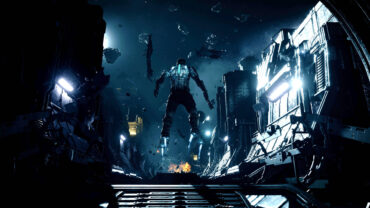During Rage 2’s year-long promotional campaign, the one promise that really stood out to me was that, this time around, you could get out of your car whenever you wanted.
Having not played the original Rage, I was a little confused. The last open-world game I played where you couldn’t get out of your car was 1999’s Driver. An open-world game coming out in 2011 that didn’t let you exit your vehicle and explore the map on foot fundamentally misunderstands what an open-world, sandbox game is, unless the player is the car.
Of course, the first Rage wasn’t really an open-world game. It was—by most accounts—a well-executed, single-player, first-person shooter with car combat sections. It was a game that gave the illusion of an open-world while funneling players through a fairly linear experience, and it had the reputation for being entirely forgettable.
Propped up next to the rest of id Software’s revolutionary FPS franchises, Rage’s failure to jumpstart the imagination was notable. As is the case with sequels to games that never really took off in the first place, Rage 2 is a shot at redemption. According to the marketing, Rage 2 is the realized promise of what the first Rage should have been.
The great philosophical question, therefore, at the center of Rage 2 is: What is Rage?
The answer, apparently, is yet another open-world shooter.
id’s commitment to doubling down on the open-world aspects of Rage is apparent within the first few seconds that you boot up the game and see the logos for both Avalanche Studios and its proprietary tech, the Apex Engine. Avalanche is a studio best known for creating some of the sandiest of boxes. Rage 2 is like an album put out by a super group, and like most super group albums, the results are hit and miss.
The first thing to know about Rage 2 is that you don’t need to have played the first Rage to follow along with the story. There’s the hint of a compelling history behind the events of the game, and opening cutscene does a decent enough job summarizing it. The short version is that, after following the ending of the original Rage, there was a 30-year war between an army of cyborg mutants called the Authority and the survivors of a cataclysmic asteroid strike that wiped out most of the life on Earth. The Authority was defeated, and the survivors either retreated back to their small settlements or took to the anarchic wasteland and generally just killed and pillaged.
You take on the role of Walker, a resident of Vineland, one of these settlements. When Vineland is attacked by the reemerging Authority, Walker (who can be a man or a woman) sets out into an apocalyptic wasteland to execute a secret order called Project Dagger and put an end to the Authority once and for all, decked out in a Ranger supersuit that gives him special abilities.
There’s a lot of potential in Rage 2’s world. It provides a goofier take on the post-apocalyptic genre. Sure, it’s hostile and psychotic, filled with residents that undoubtedly suffer from PTSD, but everyone’s largely seemed to have moved on from the tragedy that caused the end of the world and just accepted the fact that this is how life is lived now. No one’s really referring to themselves as survivors, and no one’s reminiscing about the way things were. Roaming bands of raiders and terrifying mutants are just everyday (albeit life-threatening) nuisances, and for most people, it’s the only world they’ve ever known. Even a series like Fallout, which generally takes place decades if not centuries after the cataclysmic event, still constantly refer to life before the bombs dropped. That isn’t the case with Rage 2, creating an almost fantasy-like sense of setting.
Visually, the map can go from being the empty, sandy landscape of the Broken Tract to the lush, almost prehistoric-looking Wilds, and then back to the brown-tinted fallen skyscrapers sinking into the mud that so defined the visual palette of the first game’s wasteland. Compared to certain other open-world games, where density is mistaken for quality, Rage 2’s map can seem sort of empty, like Avalanche and id took the term “sandbox” too literally. But I found that the map was more roomy than empty. The space between locations and the lack of the kind of constant detail you’d see in something like Red Dead Redemption 2or even Destiny 2 gives Rage 2’s map a surreal quality. It created this evocative, psychic landscape in my brain.
That’s not to say that there aren’t things to do in Rage 2. As you travel around the map, question marks will pop-up, hinting at important locations to check out. These icons become so plentiful that, at times, they can obfuscate the actual visual representation of the map. Most of these locations contain their own mini-arenas where you can exercise Rage 2’s immensely satisfying gunplay, and almost all of them tie into the game’s progression system. The map, in other words, offers plenty of tasks to complete if you so choose. Completing these gives you experience points towards one of the three color-coded progression trees, creating a satisfying loop and letting you focus on what aspects of your character you’d like to improve. It’s a compelling feedback loop, which is good considering there are dozens of chores to do. The only bad thing about it is that the icons for tasks you’ve completed never disappear, so the map is constantly cluttered with visual noise.
No, Rage 2’s world isn’t lacking in what some call “content.” What it’s lacking is a beating narrative heart to give itself significance.
Good open worlds have exteriors and interiors, and I mean that in an emotional sense more than a literal sense. The Witcher 3’s map is filled to the brim with icons and jaw-dropping landscapes, but it’s the narrative coursing through the world propelling you forward in your journey that makes that map so compelling. The exact opposite is why Sea of Thieves fell so flat when it first launched—and why its recent anniversary update, full of story-based quests, is finally starting to inject life and purpose into what is one of the most stunning-looking open worlds currently out there.
Rage 2 is almost entirely lacking in story. Not that this is the only signifier, but I think the main campaign took me all of seven hours to complete, if that. Obviously, great stories can be told in less time, but the problem is that Rage 2’s story—or what’s there—isn’t all the great. Basically, after you find out about Project Dagger, you have to track down the three other main figures involved in it, and do missions for them. The weird thing is, however, that each character only has two main missions to give you. And then you do one more mission, and the credits. As I approached the last mission, where I faced off against the Authority’s General Cross for the final time, I kept thinking that there would be some kind of twist that would come along to prolong my adventures. “Surely,” I thought as I rained missiles on a giant monster, “I can’t be facing the final boss. I’m going to find out that one of my friends betrayed me, and it’s going to kick off an entirely new chapter.” But, nope. I beat the monster, the credits rolled, and I was left feeling like I’d merely completed the preface to a larger adventure. There was a beginning, a middle, and an end. There was a climax and a denouement. There were even conflicts in between that I had to solve with my guns. But, from a narrative standpoint, where were the complications? Where was the deepening of the lore? Where was anything?
It doesn’t help that Rage 2’s minute-to-minute writing is surprisingly tepid for a game that takes place in a psychotic, supposedly “punk-rock” “post-post-apocalypse.” I can barely recall a single word that any of the NPCs said to me, and Walker himself is—in every sense of the phrase—a complete tool. He’s got zero personality besides “I want to kill stuff,” and he only exists to do exactly what everyone else tells him to do. There’s a weird lack of agency and self-reflection present, and the fact that he talks at all is seemingly only there to tick off another box on the list of things that Rage 2 does differently from its predecessor. You could make the argument that Walker’s nonchalance towards losing his mother figure within the first few minutes of the game is a psychological side effect of living in a world where death is the norm and life has little to no value, but the entire purpose of the story is to save the very notion of human life from an authoritarian regime that wants to turn everyone into cyborg mutant soldiers.
Neither id nor Avalanche is currently known for putting out tear-jerking, heartrending, emotionally and intellectually full stories, but Rage 2’s lack of a compelling narrative and character development stands out because the world that’s presented seems like a blank canvas for digging a little deeper into, say, a technologically advanced cult-like faction called the Immortal Shrouded that performs grotesque sacrificial rituals on its victims. As far as Rage 2 is considered, what’s important about the Immortal Shrouded is simply that you can kill them and kill them good.
Thankfully, id and Avalanche truly play to their strengths when it comes to Rage 2’s gameplay, and that’s by giving you a ton of really fun tools with which you can decimate your enemies.
Let’s start with Rage 2’s shotgun. During a previous hands-on preview, I was somewhat surprised by just how feeble the shotgun felt. The final version, however, has lived up to every expectation I had for an id Software shotty. Its standard fire mode gibs the hell out of enemies, turning them into puddles of meat, while its secondary fire mode can send them flying off cliffs and into walls with a powerful shockwave.
It’s age-old wisdom that if an FPS has a good shotgun, you’re halfway there to making a good game, and the rest of Rage 2’s arsenal mostly backs that up. The Grav-Dart gun lets you riddle an enemy full of tiny darts with the right trigger and then send them flying in a specific direction with the left. Tethering multiple enemies to a single explosive barrel at breakneck speed creates some satisfying fireworks.
Supporting the base gunplay are Rage 2’s Nanotrite abilities, basically superpowers that Walker gains from wearing a dead man’s Ranger uniform. There are four active abilities and a handful of more passive ones that you earn and upgrade that all round out the game’s combat nicely. You can force-push your enemies into oblivion, come down on them with an earth-shaking area-of-effect attack, put up a protective barrier when you’re in a tight spot, and throw a grenade that creates a tiny black hole that sucks enemies in before exploding, as well as dash around arenas to avoid incoming fire. Comboing these abilities with your weapons (e.g. sucking in enemies with a gravity grenade and then pelting them with a rocket from your missile launcher) is immensely satisfying and never gets old, despite the repetitious nature of the game’s overall mission design. Utilizing your Overdrive meter, which you fill up with every kill, you can unleash a devastating wave of attacks that will also gradually fill your health back up, and picking up Feltrite capsules that heal you (sort of like Doom 2016’s glory kills) means that you never really have to stop chaining together kills. The DNA of both developers is present in every second of Rage 2’s gameplay.
Whether or not you get all the guns and abilities is up to you. Almost every weapon and Nanotrite in Rage 2 is found within one of the game’s 12 Arks spread across the map, and this is once again where Rage 2’s story somewhat hampers the overall pacing. While some of the game’s missions will take you near enough to an Ark that you’ll at least mark it on your map, other Arks are completely hidden until you either talk to the right NPC or accidentally stumble onto it. I didn’t even have the barrier ability or three of the game’s best weapons when I finished the main campaign, which seems like an odd choice for a game that touts its combat as one of its biggest selling points.
Upgrading your guns is also a major part of unlocking the vast potential of Rage 2’s combat, but the currency you need to upgrade both your weapons and your nanotrites is the same. Again, by the time I finished the story, I’d fully upgraded all my abilities, but the only gun I upgraded at all was the shotgun. Forcing players to make this choice isn’t necessarily a bad thing, and I have no doubt that I could fully level up my character if I kept plugging away at all the side activities in the open world. But having completed the main adventure without even needing or thinking about half the upgrades made the progression system feel insignificant. That’s not a bad thing, necessarily. It’s just not satisfying, and the menu system where you make all these decisions is noticeably laggy, at least on an Xbox One S. This becomes even more apparent when you realize the only way to craft items like health kits and grenades is by going into the menu, often in the middle of a firefight. Again, it’s not a deal-breaker, but it is annoying.
The same goes for your general progression. As I mentioned before, choosing and picking what skills (or “projects”) you want to focus on by targeting specific side activities works really well in Rage 2, and I never felt like I was lacking for resources in that department. But I didn’t even realize I could upgrade Walker’s base stats like health or overall damage output before I beat the campaign. For some weird reason, these upgrades are only purchasable from a specific NPC in Wellspring, one of the game’s settlements, and not through the menu like every other upgrade.
You might have noticed that I haven’t even mentioned the car combat yet, and that’s because I tried to avoid it as much as humanly possible. You’d think that, with Avalanche and its history of developing car-related combat for games, Rage 2’s car combat would be just as exciting and memorable as its gunplay, but car combat here is some of the worst-handling and clunkiest in any of the developer’s games. When you’re cruising around the wasteland, it’s not that big of a deal, but take those same junkers onto the race course or up against a heavily armed convoy and the inconsistencies in Rage 2’s driving mechanics become harshly evident.
Most of the problems I had with Rage 2 stem from the fact that, instead of going one way with the sequel and focusing on creating a top-notch, story-driven shooter, id went the other way and focused on the series’ open-world elements. Eight years ago, if Rage was more like Rage 2, it might have been a more memorable product. By today’s standards, however, this feels like a linear shooter trapped inside an open-world game, screaming to get out. You can have a ton of fun with Rage 2, but you could probably have had more fun if id Software just stuck to its guns, literally, and made something with more focus.
|
★★★☆☆
Even after 8 years, the Rage series is still having an identity crisis. It has all the signifiers of an open-world game, but it lacks the overall narrative that makes the world compelling, and its best bits—that is, its gunfights—take places in either small, complexly designed arenas or in hallways, like a linear shooter. The greatest irony about Rage 2 is that it might have been an even better, more interesting game if it was more like the first game with a fresh coat of (pink) paint. What it is now is just a bunch of sound and fury, which can be fun for a while, but it’s ultimately an empty experience. |
Developer Avalanche Studios, id Software Publisher Bethesda Softworks ESRB M - Mature Release Date 05.13.19 |
| Rage 2 is available on PlayStation 4, Xbox One, PC. Primary version played was for Xbox One. Product was provided by Bethesda Softworks for the benefit of this coverage. EGM reviews on a scale of one to five stars. | |

Michael Goroff has written and edited for EGM since 2017. You can follow him on Twitter @gogogoroff.





